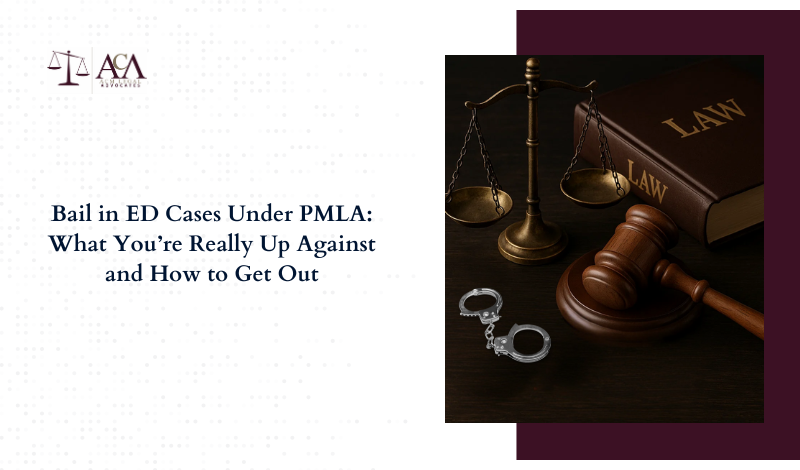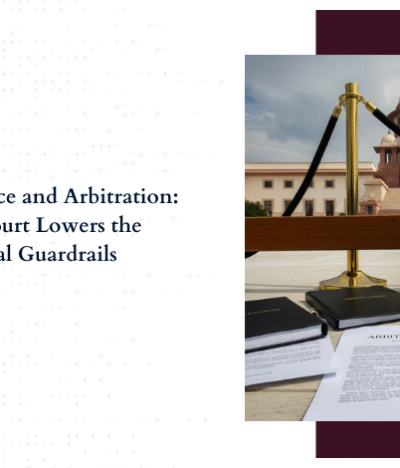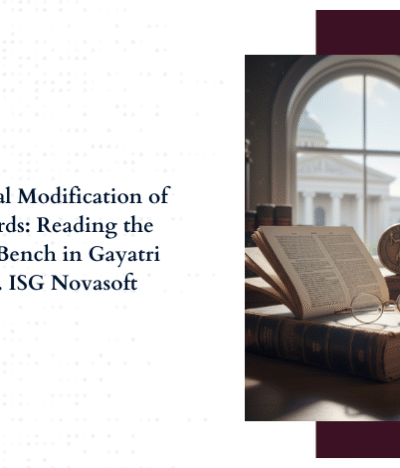The Bail Terrain Under PMLA
Let’s not sugarcoat it—getting bail in a case registered by the Enforcement Directorate (ED) under the Prevention of Money Laundering Act, 2002 (PMLA) is not business as usual. You’re not just up against procedural law; you’re staring down a special statute that’s been crafted to go after proceeds of crime, with broad powers and few limitations.
Here’s the legal terrain: the PMLA doesn’t treat bail as a matter of right. Instead, it introduces a layer of exceptional scrutiny through Section 45. This section doesn’t just lay down conditions for bail—it flips the presumption of innocence, making the accused prove that they deserve bail. That’s unusual, and it makes things complicated.
Even more, ED doesn’t act like a typical police agency. Their arrests are based on internal findings after long financial probes. They arrest less often—but when they do, they usually have something strong to rely on. So, by the time someone ends up in custody, the stakes are already high.
Now, add to that the fact that bail jurisprudence in PMLA cases has evolved sharply post-2018. Courts are more cautious. Public interest is considered. And because economic offences are seen as an attack on the nation’s financial integrity, judges are often hesitant to allow bail unless the case for it is absolutely solid.
That’s your starting point.
The “Twin Conditions” of Bail Under Section 45 PMLA
Section 45 of the PMLA imposes what are called “twin conditions” for granting bail. Under this provision, a Special Court can grant bail only if two conditions are met:
- The Public Prosecutor must be given an opportunity to oppose the bail application.
- If the Prosecutor opposes it, the court must be satisfied that:
- There are reasonable grounds for believing the accused is not guilty of the offence.
- The accused is not likely to commit any offence while on bail.
- There are reasonable grounds for believing the accused is not guilty of the offence.
Now, this is not the norm in criminal law. Typically, the burden is on the prosecution to show why bail should be denied. But under the PMLA, the burden shifts to the accused—you need to prove a negative: that you’re not guilty and won’t reoffend. It’s a high bar.
This reversal is deliberate. Parliament framed the PMLA to tackle sophisticated financial crimes that are hard to detect and prosecute. Lawmakers wanted to ensure that serious offenders don’t slip through bail loopholes. That’s why bail under PMLA feels more like a test than a right.
But here’s the real-world effect: courts are now cautious and conservative when it comes to granting bail in ED cases. Just saying “I’m innocent” won’t cut it. You need to show the court—through facts, documents, and conduct—that your case doesn’t justify pre-trial incarceration.
There are a few limited exceptions though. If the accused is a woman, a child, or medically unfit, or if the alleged offence involves laundering below ₹1 crore, the strict “twin conditions” might not apply.
But in most cases, especially involving large economic offences, these conditions stand tall—and they make getting out on bail significantly harder.
Anticipatory and Regular Bail—How They Work Differently in ED Cases
When you hear about bail in ED cases, there are usually two stages to consider: anticipatory bail (before arrest) and regular bail (after arrest). Under PMLA, the approach to both is fundamentally different from regular IPC cases.
Anticipatory Bail in ED Investigations
Getting anticipatory bail under PMLA is tough—and honestly, rare. Why? Because courts are reluctant to pre-emptively protect someone from arrest in money laundering cases unless they’re absolutely convinced the arrest would be unjustified.
What do courts look for?
- Whether the accused has been cooperating with the investigation.
- Whether the accused has already responded to ED summons.
- Whether there’s any risk of flight or tampering with evidence.
- Whether the material available shows prima facie involvement in laundering.
If the ED is yet to arrest you and you file for anticipatory bail, you’ll need to present a solid case that you’ve done everything by the book. It’s not about denial of guilt—it’s about establishing that custodial interrogation isn’t necessary.
But even with all that, if the amount involved is large or the ED has already gathered strong evidence, the chances of getting anticipatory bail drop significantly. Courts often err on the side of caution and allow ED to arrest and interrogate first, especially if the case involves shell companies, foreign transactions, or layered fund movements.
Regular Bail After ED Arrest
Once you’re arrested, the next logical step is regular bail. And this is where the “twin conditions” of Section 45 fully come into play. By now, the ED has likely taken you into custody for a few days, recorded your statements, and gathered more material. They may or may not have filed the prosecution complaint (chargesheet) yet.
When applying for regular bail, your lawyer will need to address:
- The gravity of allegations.
- The amount laundered and your role in it.
- Whether the “proceeds of crime” are traceable, attached, or still being hidden.
- Your past criminal record, if any.
- The stage of the investigation and whether it’s concluded.
Sometimes, delay in filing the chargesheet or the completion of ED custody without any substantial new leads can be a strong ground for regular bail. Courts also look at whether prolonged judicial custody is justified in the absence of trial progress.
In essence, anticipatory bail is a long shot unless your facts are clean. Regular bail is slightly more attainable but only with the right mix of legal strategy, documentation, and timing.
What Actually Works in PMLA Bail Applications
A bail application in an ED case under PMLA isn’t just a formal request—it’s a strategic document. You don’t win bail in these matters by throwing in a few standard lines about constitutional liberty or overcrowded jails. You need to build a story. A credible one. One that the judge can believe in and sign off on.
What Judges Really Want to See
Let’s talk about what actually moves the needle:
1.Cooperation with ED
Show that you haven’t run, evaded summons, or obstructed the investigation. If you’ve appeared before ED multiple times, include those dates. This shows you’re not a flight risk.
2.Document the Clean Trail
If the ED alleges proceeds of crime, your job is to point to the legitimate source of funds. Whether it’s audited financials, GST returns, income tax filings, or transaction records—use them to show that the money is traceable, explained, and not layered through dummy entities.
3. No Tampering Risk
If you’re not in a position to influence witnesses or destroy evidence, highlight that. If the key documents are already with the ED, argue that custody is no longer necessary.
4. Medical Grounds (If Genuine)
This isn’t a golden ticket, but it helps. Especially if you suffer from chronic illness or need regular hospital visits, and jail facilities aren’t equipped to manage that.
5. Delay or Lack of Progress in Trial
If the prosecution complaint hasn’t been filed within the stipulated 60 or 90 days, or the trial hasn’t begun months after arrest, that can be used to argue for bail based on infringement of fair trial rights.
6. Personal Conduct & Background
If you’re a first-time offender, have strong community ties, or professional credibility, build that into your argument. Courts may not grant bail purely out of sympathy, but these things can weigh in your favour.
Format and Substance Matter
Drafting style matters more than people admit. Avoid generic copy-paste petitions. Each bail plea should:
- Address the specific allegations head-on.
- Quote relevant portions of ED’s ECIR or remand applications, if available.
- Explain your personal involvement clearly.
- Preempt prosecution arguments wherever possible.
And if you can get a good verification from a neutral third party (like a chartered accountant explaining the trail of funds), attach it.
Conclusion
Bail in ED cases under PMLA isn’t just about law—it’s about preparation, timing, and credibility.
If you walk into court unprepared, with a generic bail plea and no control over the narrative, the ED will drive the case. And when they do, the story they tell will be about crime, concealment, and national interest.
Getting bail in ED cases under PMLA is difficult—but not impossible. The law may be loaded against the accused, but with the right mix of factual defence, legal reasoning, and procedural strategy, bail is very much within reach.
Don’t play it like a routine criminal case. Treat it as a high-stakes litigation from Day One. That mindset shift alone can change the outcome.
Frequently Asked Questions: Bail in ED Cases under PMLA
Q1: What is the process for getting bail in an ED case under PMLA?
To get bail in a PMLA case, you must apply before the Special Court (usually designated PMLA courts). The Enforcement Directorate must be given a chance to oppose the bail, and you must satisfy the court that you’re not guilty and won’t commit another offence while out on bail. These are the “twin conditions” under Section 45 of PMLA. The court will also look at your role, cooperation, risk of flight, and whether the investigation is complete.
Q2: Can anticipatory bail be granted in ED cases?
Yes, but it’s rare. Courts are cautious about granting anticipatory bail in money laundering cases unless there is clear evidence that the arrest is unnecessary. Factors like voluntary cooperation, no criminal history, and medical vulnerabilities can improve your chances. Still, anticipatory bail is an uphill task unless your case stands out factually.
Q3: Are the twin conditions of Section 45 PMLA always applicable?
Not always. The twin conditions may not apply if:
- The alleged laundering amount is less than ₹1 crore.
- The accused is a woman, minor, or medically unfit.
- The offence is punishable with imprisonment of less than three years (rare under PMLA).
Otherwise, in most ED matters involving large-scale laundering, Section 45 applies in full force.
Q4: How long can ED keep someone in custody before filing charges?
The ED can keep the accused in custody after arrest for up to 15 days—first in ED custody (as permitted by the court), then in judicial custody. They must file a prosecution complaint (similar to a chargesheet) within 60 or 90 days, depending on the offence’s gravity. Delay in filing can be a ground for regular bail.
Q5: What happens if ED has already attached the property in question?
If the alleged “proceeds of crime” are already provisionally attached or under adjudication by the Adjudicating Authority, it can work in your favour. The risk of tampering with assets is reduced, which can be a valid point in favour of granting bail.






